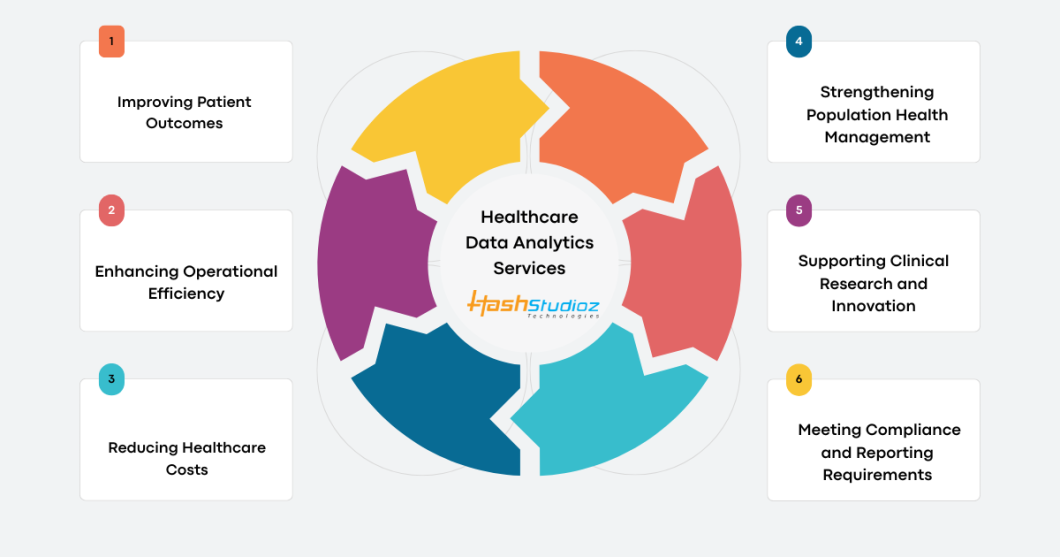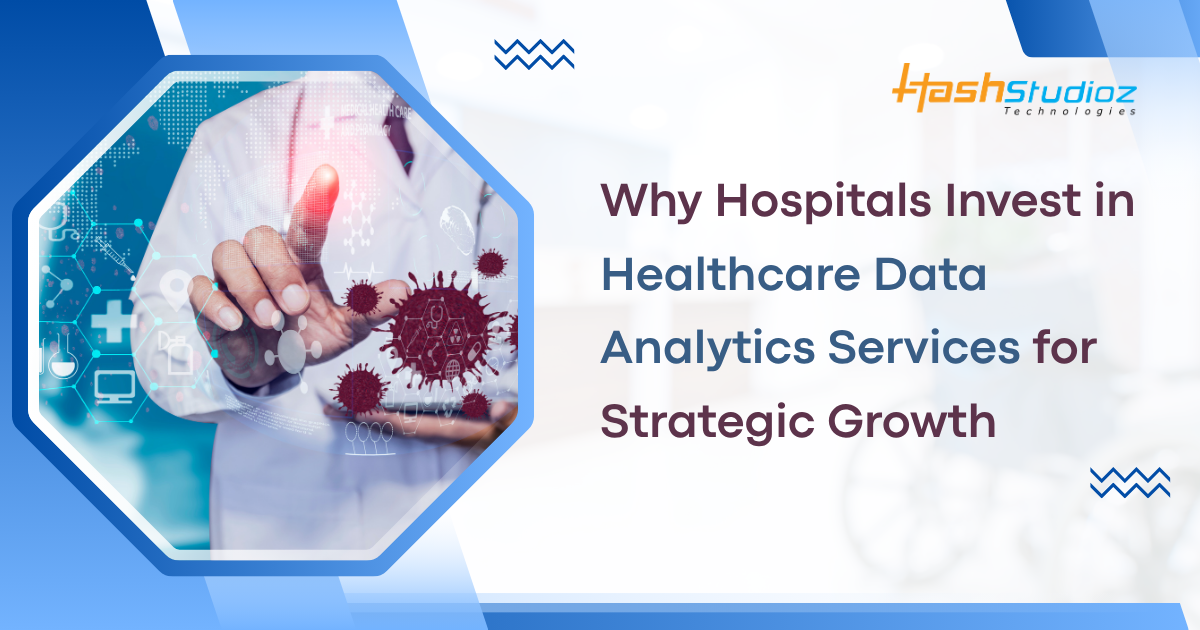Healthcare organizations today handle vast amounts of data from clinical systems, patient records, diagnostic devices, and insurance platforms. However, raw data by itself holds little value until it is processed, analyzed, and translated into actionable insights.
Hospitals now recognize that Healthcare Data Analytics Services are critical for strategic decision-making, operational efficiency, and improved patient outcomes. These services help transform scattered data into meaningful patterns that drive both clinical and business improvements.
Table of Contents
- Growing Role of Data Analytics in Healthcare
- Understanding Healthcare Data Analytics
- Why Hospitals Are Investing in Healthcare Data Analytics Services
- Challenges in Implementing Healthcare Data Analytics
- Case Example: Using Analytics to Reduce Readmissions
- Measuring the Success of Healthcare Analytics
- Future of Healthcare Data Analytics
- Why Choose HashStudioz for Healthcare Data Analytics Services?
- Conclusion
Growing Role of Data Analytics in Healthcare
The healthcare sector is one of the most data-intensive industries in the world. Every patient visit, lab test, and prescription adds new information to digital systems.
- According to recent reports, healthcare data volume is expected to grow at a 36% annual rate through 2027—faster than any other industry.
- By 2030, the global Healthcare Data Analytics market is projected to exceed $80 billion, driven by the adoption of AI, predictive analytics, and electronic health records (EHRs).
- More than 60% of hospitals in developed countries now use analytics platforms for administrative and clinical decision support.
These numbers show that hospitals are not just collecting data—they are investing heavily in analyzing it for strategic advantage.
Understanding Healthcare Data Analytics
Healthcare Data Analytics refers to the systematic use of data analysis tools and techniques to evaluate medical, operational, and financial information. It helps hospitals understand trends, predict outcomes, and make evidence-based decisions.
Analytics in healthcare is usually categorized into four main types:
- Descriptive Analytics – Answers “What happened?” by summarizing historical data. Example: Monthly readmission rates or average treatment costs.
- Diagnostic Analytics – Explains “Why it happened?” by identifying root causes. Example: Analyzing factors behind increased emergency visits.
- Predictive Analytics – Forecasts “What is likely to happen?” using machine learning models. Example: Predicting patient deterioration risks.
- Prescriptive Analytics – Suggests “What should be done?” by recommending actions. Example: Identifying optimal staffing levels for specific wards.
Healthcare Data Analytics Services combine these techniques to give hospitals a clear view of clinical performance, patient care quality, and financial sustainability.
Why Hospitals Are Investing in Healthcare Data Analytics Services
Hospitals face constant pressure to improve care quality while controlling costs. Investing in data analytics offers multiple strategic advantages that help them achieve both goals.
1. Improving Patient Outcomes
Data analytics helps physicians make faster and more informed decisions. Predictive models can identify patients at high risk of complications or readmissions.
For example:
- Machine learning algorithms can analyze EHR data to detect early signs of sepsis or heart failure.
- Clinical dashboards help monitor vital signs in real-time and alert staff to potential emergencies.
A hospital using predictive analytics can reduce readmission rates by up to 25% and improve overall survival outcomes.

2. Enhancing Operational Efficiency
Hospitals operate complex systems—bed management, supply chains, staffing, and scheduling. Data analytics provides visibility into these operations.
Examples include:
- Analyzing patient flow to optimize bed allocation.
- Monitoring equipment utilization rates to plan maintenance.
- Predicting staffing needs based on seasonal or demographic patterns.
According to industry analysis, hospitals applying operational analytics achieve 10–15% cost reduction and 20% faster patient throughput.
3. Reducing Healthcare Costs
Medical errors, redundant tests, and inefficient resource use increase costs significantly. Analytics helps identify and eliminate waste.
For instance:
- Cost analytics can compare treatment outcomes across departments and identify areas of overspending.
- Automated reporting systems can flag duplicate imaging or lab tests.
Studies show hospitals using Healthcare Data Analytics Services can lower total healthcare costs by up to 12% annually.
4. Strengthening Population Health Management
Hospitals are responsible not only for individual care but also for population health. Analytics helps track disease prevalence and target preventive programs.
Examples:
- Using demographic and lifestyle data to predict chronic disease risks.
- Identifying high-risk populations for vaccination or screening campaigns.
With analytics, hospitals can reduce chronic disease hospitalizations by 18–25%, improving community health outcomes and reducing long-term costs.
5. Supporting Clinical Research and Innovation
Analytics platforms help researchers identify treatment patterns and discover new clinical insights.
Hospitals can analyze anonymized datasets to evaluate drug efficacy or treatment success across patient populations.
6. Meeting Compliance and Reporting Requirements
Hospitals must comply with numerous regulations like HIPAA, ICD-10, and value-based care reporting.
Analytics tools simplify compliance by automating data collection and validation.
They generate accurate reports for authorities, reduce manual errors, and ensure data privacy standards are met.
Challenges in Implementing Healthcare Data Analytics
While analytics provides immense value, hospitals face certain technical and organizational challenges.
1. Data Privacy and Security
Protecting sensitive healthcare data requires strict access controls, encryption, and compliance with regulations like HIPAA to prevent breaches and maintain patient trust and organizational reputation.
2. Data Interoperability
Different hospital systems use incompatible formats, complicating data sharing. Unified data models, APIs, and interoperability frameworks enable seamless integration across departments for efficient information exchange.
3. Data Quality and Accuracy
Incomplete or inconsistent data leads to flawed analytics and poor decisions. Regular validation, cleansing, and governance ensure reliable, standardized data for accurate healthcare insights.
4. High Implementation Costs
Building analytics infrastructure demands significant investment in technology and skilled staff. Hospitals often recoup these costs through improved operations, efficiency, and long-term savings.
5. Skill Gap
Hospitals face shortages of data science and analytics experts. Partnering with specialized Healthcare Data Analytics Services helps fill this gap with expertise and ongoing support.
Case Example: Using Analytics to Reduce Readmissions
A large hospital used predictive analytics on EHRs and patient data to identify those at high risk of readmission within 30 days. Care teams then provided personalized follow-ups, home visits, and telehealth monitoring.
Results Achieved
- Readmissions decreased by 20% within six months of implementation.
- Average cost per patient dropped by $1,200, improving financial performance.
- Patient satisfaction scores increased by 15%, reflecting improved care quality and engagement.
This case demonstrates how Healthcare Data Analytics enables hospitals to make proactive, data-driven decisions that enhance patient outcomes while optimizing operational and financial performance.
Measuring the Success of Healthcare Analytics
Hospitals evaluate Healthcare Data Analytics using Key Performance Indicators (KPIs) across clinical, operational, and financial areas. These metrics help track the impact of analytics on patient care, efficiency, and revenue.
1. Clinical KPIs
- Reduction in Hospital-Acquired Infections: Analytics tracks infection trends and hygiene compliance to lower infection rates.
- Lower Readmission Rates: Predictive models identify high-risk patients for targeted post-discharge care, reducing readmissions.
- Improvement in Treatment Adherence: Monitoring medication and follow-ups helps improve patient compliance and outcomes.
2. Operational KPIs
- Bed Occupancy Rates: Forecasting admissions optimizes bed use and prevents overcrowding.
- Average Patient Wait Times: Analytics reduces delays by managing patient flow and resource allocation.
- Staff Utilization Efficiency: Evaluates workloads to deploy staff effectively and reduce burnout.
3. Financial KPIs
- Cost per Patient Case: Identifies inefficiencies to lower costs without affecting care quality.
- Revenue Cycle Efficiency: Tracks billing and payments to reduce errors and speed revenue collection.
- Billing Accuracy and Claim Approval Rates: Ensures correct coding for faster claim approvals and fewer denials.
Future of Healthcare Data Analytics
The future of Healthcare Data Analytics is being shaped by rapid advancements in artificial intelligence (AI), the Internet of Things (IoT), big data technologies, and real-time computing. These innovations are transforming how hospitals collect, process, and apply data to improve patient care and operational performance.
1. Predictive and Preventive Care
Predictive analytics analyzes patient history and genetics to identify disease risks early, enabling preventive screenings, personalized health programs, and timely interventions that reduce hospitalizations and improve long-term patient outcomes.
2. AI Integration in Clinical Decision Support
AI uses machine learning and large language models to analyze complex medical data, supporting faster, more accurate diagnoses and personalized treatment recommendations, reducing errors and enhancing clinical workflow efficiency.
3. Remote Patient Monitoring
IoT devices collect real-time health data like heart rate and blood pressure, enabling continuous monitoring, early detection of issues, fewer hospital visits, and improved chronic disease management via telehealth.
4. Data Interoperability Standards
Adoption of standards like FHIR and HL7 enables seamless, secure data exchange across healthcare systems, ensuring providers access complete patient records for faster diagnosis and coordinated, continuous care.
5. Personalized Medicine
Analytics integrates genomics, medical history, and lifestyle data to customize treatment plans. This approach improves therapy accuracy, reduces side effects, and enhances survival rates, especially in fields like oncology.
Why Choose HashStudioz for Healthcare Data Analytics Services?
At HashStudioz, we understand that every healthcare organization has unique data challenges and goals. That’s why we deliver personalized Healthcare Data Analytics Services designed specifically for your hospital’s needs. Our skilled team combines extensive healthcare expertise with the latest technologies to create analytics solutions that improve patient outcomes and optimize operations.
Here’s what sets HashStudioz apart:
- Tailored Solutions: We customize analytics strategies to fit your specific clinical and operational requirements.
- Advanced Technology: We use cutting-edge AI, machine learning, and data integration tools to deliver actionable insights.
- End-to-End Support: From data collection and processing to predictive modeling and reporting, we handle the entire analytics lifecycle.
- Healthcare Expertise: Our team has deep knowledge of healthcare workflows, regulations, and data standards like HIPAA and HL7.

Conclusion
Hospitals are no longer relying on intuition alone for decision-making. They are investing in Healthcare Data Analytics Services to gain measurable insights that improve care quality, reduce costs, and support strategic growth.
Through advanced analytics, hospitals can detect health trends, predict patient outcomes, and allocate resources effectively. The combination of technology, data, and domain expertise is shaping a more intelligent healthcare ecosystem.

